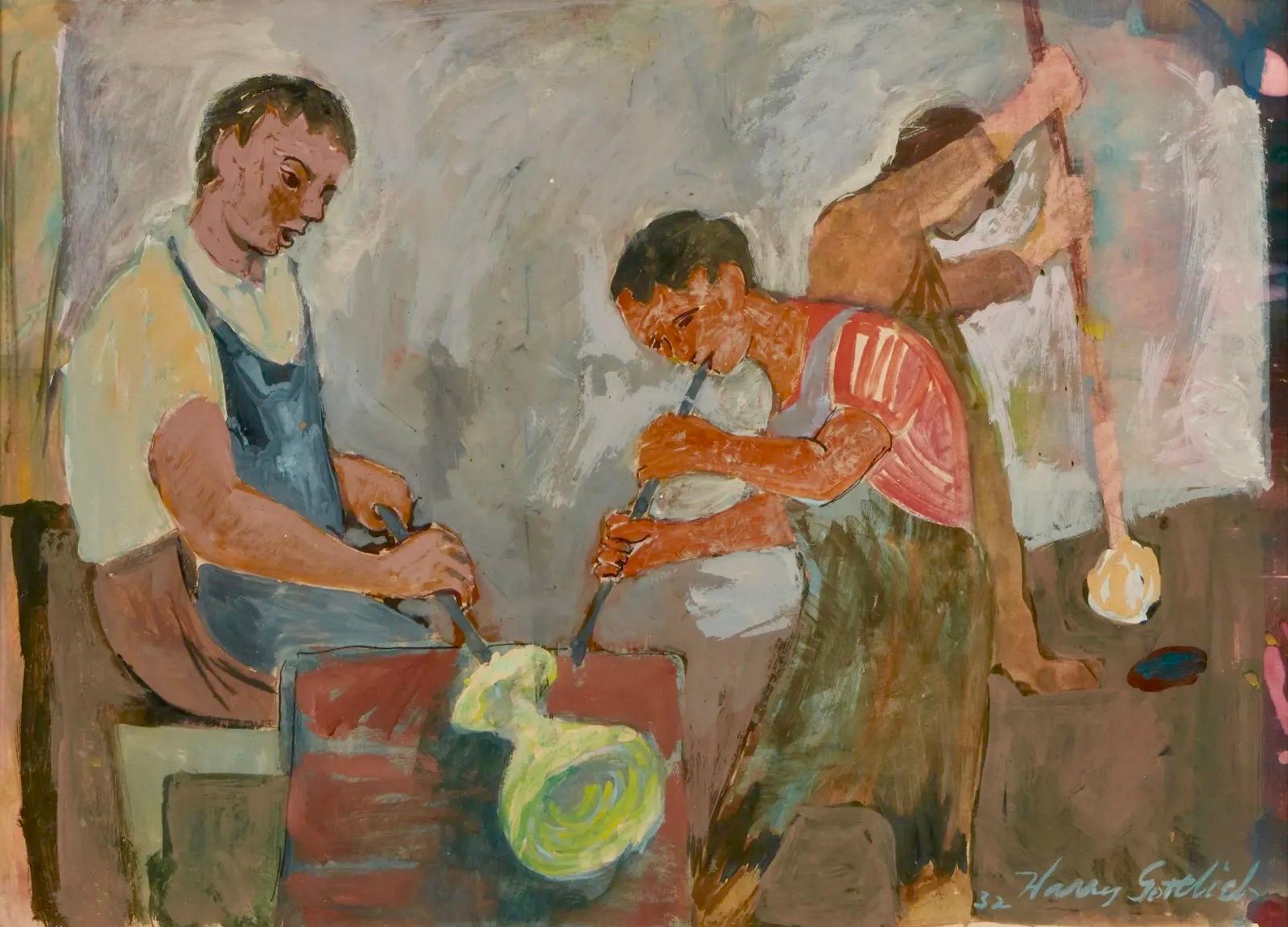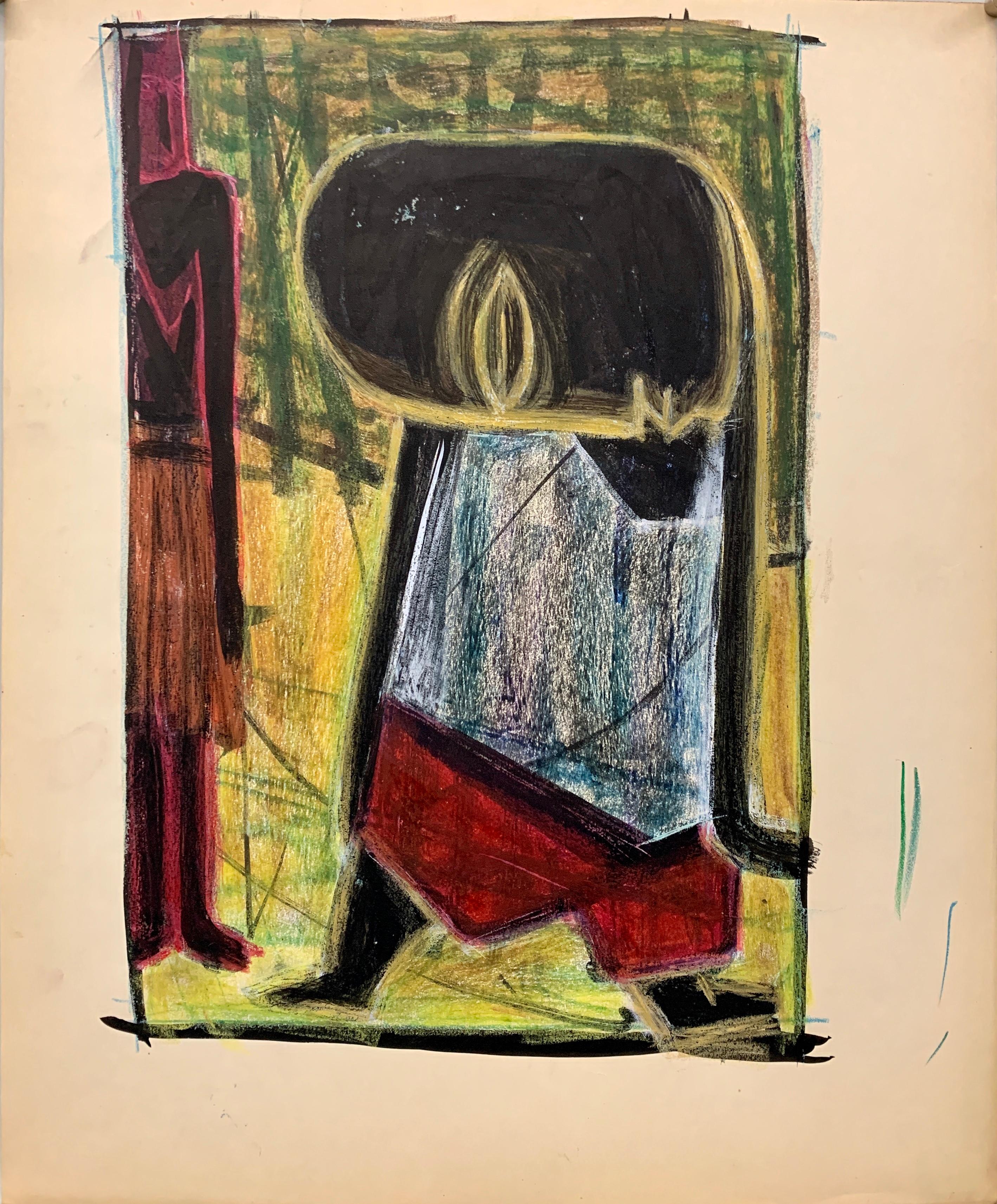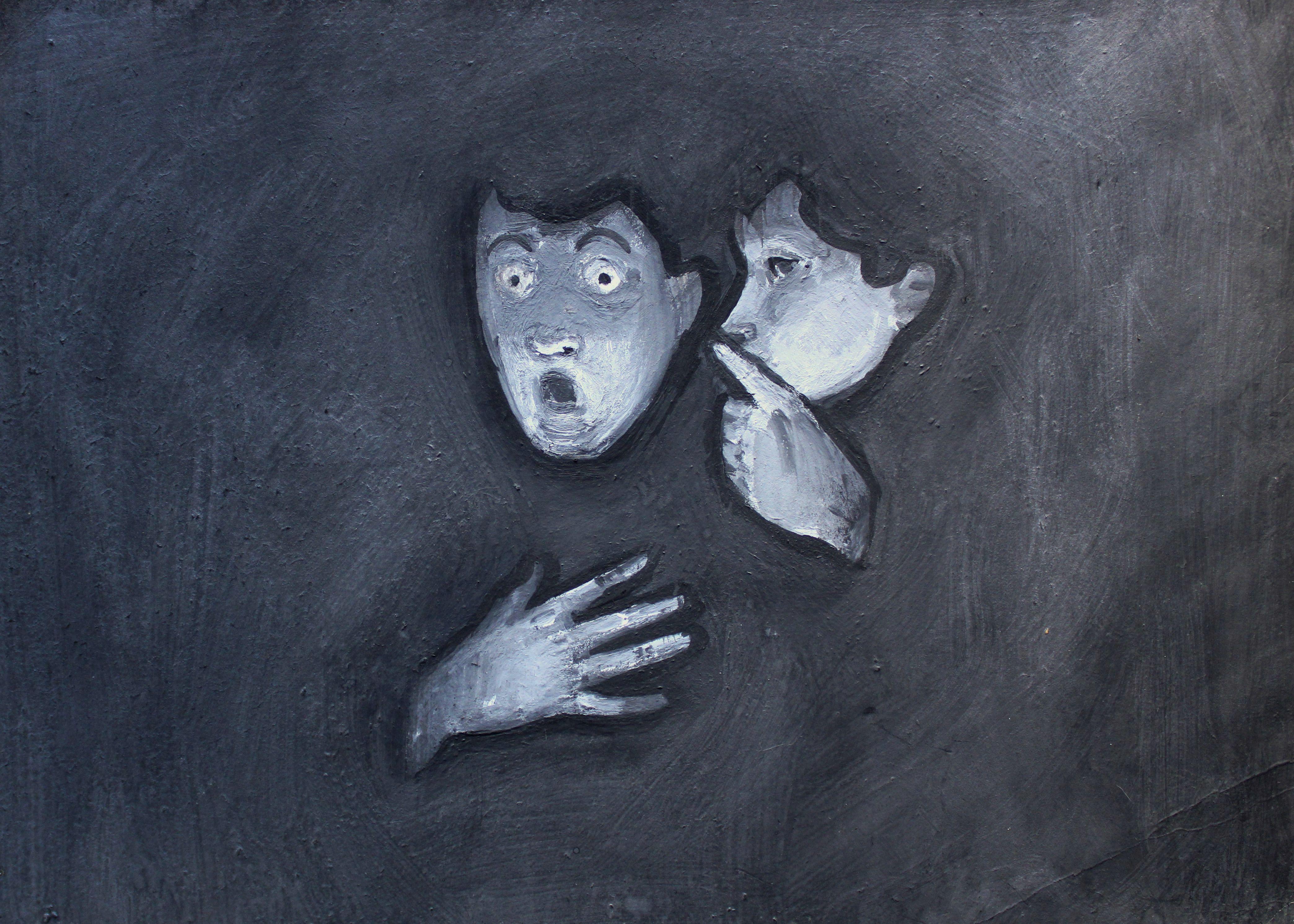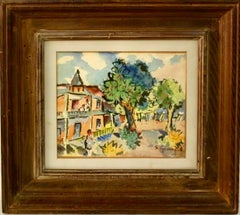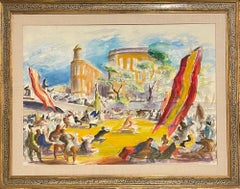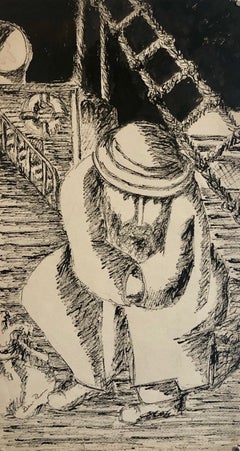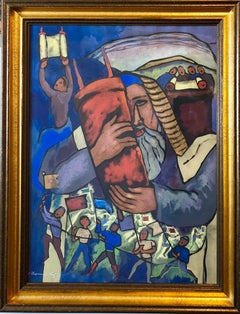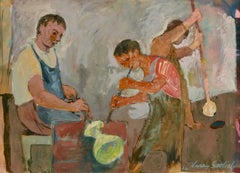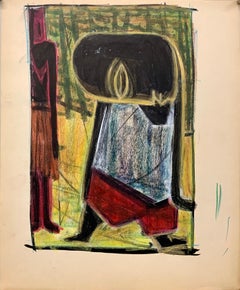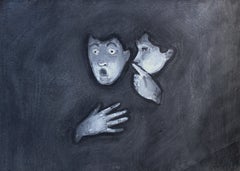Items Similar to 1940's American WPA Modernist New York City Watercolor Painting Tenement Market
Want more images or videos?
Request additional images or videos from the seller
1 of 12
Samuel Grunvald1940's American WPA Modernist New York City Watercolor Painting Tenement Marketc.1940s
c.1940s
About the Item
The Market, (fauvist painting of NYC scene) 1940's.
image is 10X 11.5 inches. Hand signed lower right
Lower East Side Tenements Pushcart Market
Samuel Grunvald was a Hungarian born American WPA artist known for abstract, landscape and seascape paintings.
Arrived in the USA from Hungary in 1921 and settled in New York City where he studied at the Art Students League. Grunvald worked for the Federal Art Project, taught at Colony House in NYC. Member: Art Guild, Watercolor Society, New York Watercolor Club. exhibited at Montross Gallery, NYC, World House Galleries, NYC, Leonard Hutton Gallery, NYC, Associated American Artists Gallery and the A.C.A. Gallery. Gunvald's work spanned many modern American movements from the WPA to Abstract Expressionist painting. He was a member of the American Watercolor Society and the Brooklyn Society of Artists. He exhibited with both of these organizations and at the Brooklyn Museum of Art. He was involved the the WPA being a Federal Arts Project artist. A number of prominent Jewish artists participated in this New Deal program among them Ben Shahn, Joseph Solman, William Gropper, Philip Guston Adolph Gottlieb, Mark Rothko, Milton Avery, Ben Shahn, the Soyers (Isaac, Moses, and Raphael), and many others
Grunwald exhibited alongside other popular artists such as Paul Klee, Jean Arp, Max Ernst and Charles Burchfield. He also taught and lectured on art and easel painting, Federal Art Project, NYC. His work is included in the collections of the Museum of Modern Art and The Jewish Museum, New York. Americana.
Select Exhibitions
A.C.A. Gallery
Associated American Artists Gallery, 1936-1955
American Watercolor Society, 1932-1942
New York Watercolor Club, 1935-1937
Humanist Art Fair, 1935
Montross Gallery, 1933, 1935
Brooklyn Museum, Brooklyn Society of Artists, 1942
Contemporary Arts, 1939, 1941, 1943, 1947, 1949, 1950, 1952, 1954-57
UAA Annual Exhibition 1940
Leonard Hutton Gallery, New York 1960
World House Galleries, New York 1959
Florence Wilson Gallery, 1962
- Creator:Samuel Grunvald (1893 - 1983, American, Hungarian)
- Creation Year:c.1940s
- Dimensions:Height: 16 in (40.64 cm)Width: 18 in (45.72 cm)
- Medium:
- Movement & Style:
- Period:
- Condition:good. minor toning. wear to frame.
- Gallery Location:Surfside, FL
- Reference Number:1stDibs: LU38211278352
About the Seller
4.9
Platinum Seller
Premium sellers with a 4.7+ rating and 24-hour response times
Established in 1995
1stDibs seller since 2014
1,766 sales on 1stDibs
Typical response time: 1 hour
- ShippingRetrieving quote...Shipping from: Surfside, FL
- Return Policy
Authenticity Guarantee
In the unlikely event there’s an issue with an item’s authenticity, contact us within 1 year for a full refund. DetailsMoney-Back Guarantee
If your item is not as described, is damaged in transit, or does not arrive, contact us within 7 days for a full refund. Details24-Hour Cancellation
You have a 24-hour grace period in which to reconsider your purchase, with no questions asked.Vetted Professional Sellers
Our world-class sellers must adhere to strict standards for service and quality, maintaining the integrity of our listings.Price-Match Guarantee
If you find that a seller listed the same item for a lower price elsewhere, we’ll match it.Trusted Global Delivery
Our best-in-class carrier network provides specialized shipping options worldwide, including custom delivery.More From This Seller
View All1940's Americana WPA Modernist Watercolor Painting Catskill Mountains Bungalow
By Samuel Grunvald
Located in Surfside, FL
Bungalow (fauvist painting of New York scene) 1940's.
image is 10X 11.5 inches. Hand signed lower right
Country Scene
Samuel Grunvald was a Hungarian born American WPA artist known for abstract, landscape and seascape paintings.
Arrived in the USA from Hungary in 1921 and settled in New York City where he studied at the Art Students League. Grunvald worked for the Federal Art Project, taught at Colony House in NYC. Member: Art Guild, Watercolor Society, New York Watercolor Club. exhibited at Montross Gallery, NYC, World House Galleries, NYC, Leonard Hutton Gallery, NYC, Associated American Artists Gallery and the A.C.A. Gallery. Gunvald's work spanned many modern American movements from the WPA to Abstract Expressionist painting. He was a member of the American Watercolor Society and the Brooklyn Society of Artists. He exhibited with both of these organizations and at the Brooklyn Museum of Art. He was involved the the WPA being a Federal Arts Project artist. A number of prominent Jewish artists participated in this New Deal program among them Ben Shahn, Joseph Solman, William Gropper, Philip Guston Adolph Gottlieb, Mark Rothko, Milton Avery, Ben Shahn, the Soyers (Isaac, Moses, and Raphael), and many others
Grunwald exhibited alongside other popular artists such as Paul Klee, Jean Arp, Max Ernst and Charles Burchfield. He also taught and lectured on art and easel painting, Federal Art Project, NYC. His work is included in the collections of the Museum of Modern Art and The Jewish Museum, New York. Americana.
The Catskills became a major resort destination for Jewish New Yorkers in the mid-20th century. Borscht Belt is an informal term for the summer resorts of the Catskill Mountains in Sullivan and Ulster counties in upstate New York which were frequented by Ashkenazi Jews. At its peak of popularity, about 500 resorts operated in the region. Later changes in vacationing patterns have led most of those travelers elsewhere, although there are still bungalow communities and summer camps in the towns of Liberty, Bethel, Monticello and Fallsburg catering to Orthodox Jewish populations. Borscht Belt, The term, which derives from the name of a beet soup popular with people of Eastern European origin, can also refer to the Catskill region itself.
In August, 1969, the Catskills were the site of a music and art festival in the town of Bethel, which had originally been planned for Woodstock, New York. Thirty-three of the best-known musicians of the era appeared during a sometimes rainy weekend in front of nearly half a million concertgoers. The event, featuring liberal drug use and nudity, exemplified the counterculture of the 1960s and 1970s.
Select Exhibitions
A.C.A. Gallery
Associated American Artists Gallery, 1936-1955
American Watercolor Society, 1932-1942
New York Watercolor Club, 1935-1937
Humanist Art...
Category
1940s Modern Figurative Drawings and Watercolors
Materials
Watercolor
Large Watercolor Painting John Groth, Men Wrestling, Esquire Magazine WPA Artist
By John Groth
Located in Surfside, FL
John August Groth (American, 1908-1988)
"Wrestling Match,"
Watercolor painting, hand signed upper right and inscribed upper left, "Las Palmas Canary Islands Lucha Canary Wrestling".
Framed Size: 21'' x 29'', 53 x 74 cm (sight); 28.5'' x 36.25'', 72 x 92 cm (frame).
Depiction of a wrestling match in a city square.
John August Groth (1908 - 1988) was an illustrator and art teacher. He gained recognition as a war correspondent-illustrator. He studies at the Art Institute of Chicago and at Art Students League with Todros Geller, Robert Brackman, Arnold Blanch and George Grosz.
He was a member: Society of American Etchers; American Newspaper Guild; Society of Illustrators; Associate Member of the National Academy of Design; American Water Color Society.
Positions : Art Director at Esquire 1933 - 1937, Parade Publications 1941 - 1944; War Correspondent for Chicago Sun 1944; American Legion Magazine 1945; Artist-Correspondent in Vietnam 1967.Teacher at Art Students LeagueHe was the first art director of Esquire Magazine and taught at the Art Students League, the Pratt Institute, and the Parsons School of Design.
In 1940, he was included in an exhibition at MOMA, titled, "PM Competition: The Artist as Reporter." The exhibition included Philip Guston, Reginald Marsh, John Tworkov, John Heliker, Adolf Dehn, and Chet La More.
Groth began sketching intently during the Great Depression after studying at the Art Institute of Chicago. Following the advice of an editor, he penned 100 sketches a day for years. He learned to increase his speed by listening to sports on the radio and sketching the action as fast as he could. "I would listen to the games on the radio at night, and sketch the plays. It made me very quick." His break came when Arnold Gingrich, an editor for Esquire magazine, approached him at an art show in Chicago and offered him a position. "The way (Arnold Gingrich) told it," John Groth says, "he found this barefoot, bearded kid in the park, and the next day made him art director of the world's leading men's fashion magazine. But I swear I was wearing shoes." Groth went on to work as a correspondent and illustrator for the Chicago Sun, Collier's, Sports Illustrated, and The Saturday Evening Post.
He developed a passion for war zones. He covered six different wars and was one of the first correspondents in Paris after its liberation. "It is only at war that I feel complete... There, you meet all sort of men -- farmers, mechanics, college professors. It rains on them and it rains on you. The shells burst in the air, and you are there, too." He would make a splash when he beat out friend and rival, Ernest Hemingway, into Paris in 1944. Hemingway was writing for the Chicago Tribune and Groth for the Chicago Sun. Groth was in the first jeep into Paris and got the scoop. His headline read, "Yanks are in Paris!" Hemingway would later write about Groth's technique. “None of us understood the sort of shorthand he sketched in. The men would look at the sketches and see just a lot of lines. It was a great pleasure to find what fine drawings they were when we got to see them.
Groth went on to illustrate such classic books as: A Christmas Carol, All Quiet on the Western Front, The Grapes of Wrath, The War Prayer, and Gone with the Wind.
Deborah Churchman described Groth's work in a 1980 Washington Post article: "Groth's pictures center on the day-to-day life of people caught in terrifying circumstances -- armies occupying cities, soldiers sweeping roads for land mines, bullfighters facing death." Bernie Schonfeld, a photographer for Life Magazine said of Groth, "John is one of the gentlest people in the world, and he always gets himself into the wildest hell hole." He joined the First Congress of American Artists Against War and Fascism in 1936, along with Stuart Davis, Peter Blume...
Category
Mid-20th Century American Modern Figurative Paintings
Materials
Paper, Watercolor
Modernist Judaica Jewish Ink Drawing Painting "New Immigrant" Off the Boat WPA
By Ben-Zion Weinman
Located in Surfside, FL
An ink drawing Judaic painting by modern artist Ben-Zion Weinman. It depicts a portrait of an old Jewish man. Coming over from Europe on a ship crossing. The work is signed "Ben-Zion".
Born in 1897, Ben-Zion Weinman celebrated his European Jewish heritage in his visual works as a sculptor, painter, and printmaker. Influenced by Spinoza, Knut Hamsun, and Wladyslaw Reymont, as well as Hebrew literature, Ben-Zion wrote poetry and essays that, like his visual work, attempt to reveal the deep “connection between man and the divine, and between man and earth.”
An emigrant from the Ukraine, he came to the US in 1920. He wrote fairy tales and poems in Hebrew under the name Benzion Weinman, but when he began painting he dropped his last name and hyphenated his first, saying an artist needed only one name. In 1920 he settled in America, where he found little interest in his writing. He began teaching Hebrew to support himself and then in the early 1930s returned to painting. He used his art to comment on the rise of fascism in Europe, events he felt could not be adequately explored with words. Largely self-taught, Ben-Zion visited the museums of New York City to learn his new trade. His first painting on a large scale, Friday Evening (1933, Jewish Museum, New York), depicts a Sabbath dinner table as recalled from his family home. Ben-Zion supported himself by working odd jobs until the establishment of the Works Progress Administration's Federal Art Project. Under the auspices of the wpa, Ben-Zion thrived and galleries began to show his work. In 1936, after his first one-man show at the Artists' Gallery in New York
Ben-Zion was a founding member of “The Ten: An Independent Group” The Ten” a 1930’s...
Category
1940s American Modern Figurative Paintings
Materials
Watercolor, Gouache
Chicago Jewish Modernist Judaica Painting Simchat Torah WPA Artist Israeli Flags
By Alexander Raymond Katz
Located in Surfside, FL
This has young ISraeli pioneers dancing with the flag as typical of works of the late British mandate Palestine era early state of Israel.
Genre: Modern
Subject: Figurative (stained glass style)
Medium: Mixed media gouache on paper
Hand signed lower left
Alexander Raymond Katz, Hungarian / American (1895 – 1974)
Alexander Raymond Katz was born in Kassa, Hungary, and came to the United States in 1909. He studied at the Art Institute of Chicago and the Chicago Academy of Fine Arts. In the late 1920s, he worked as a director of the Poster Department at Paramount Studios. He was appointed the Director of Posters for the Chicago Civic Opera in 1930.
During the Great Depression, notable architect Frank Lloyd Wright urged Katz to become a muralist. In 1933, he was commissioned to paint a mural for the Century of Progress exposition in Chicago. In 1936, he painted the mural History of the Immigrant for the Madison, Ill., post office. Katz’s works were included in various exhibitions and now are part of several museum collections, including those of the Art Institute of Chicago; Corcoran Gallery of Art, Washington, D.C.; and the Jewish Museum, New York. His murals, bas-reliefs and stained glass designs adorn more than 200 Jewish synagogues in the United States.
Katz and other Jewish artists in Chicago who expressed Jewish and Biblical themes were inspired by the artist Abel Pann (1883-1963). Pann, who is regarded as the leading painter of the Land of Israel, exhibited in the Art Institute of Chicago in 1920.
Early in his career, Katz began to explore the artistic possibilities inherent in the characters of the Hebrew alphabet. He developed aesthetic and philosophical interpretations of each letter and became the leading innovator and pioneer in the field of Hebraic art.
Katz applies this concept in the woodcut Moses and the Burning Bush. Hebrew letters appears in Moses’ head, his cane and inside the flame. The initial of Moses’ name crowns his head. The letter in the flame is the first letter of the name of God. A combination of images and Hebrew letters appeared commonly in illustrations of the scene Moses and the Burning Bush in the Haggadah, the book of Passover.
The symbolism of the burning bush corresponds to the motifs of A Gift to Biro-Bidjan. Among the fourteen participating artists were notable Chicago modernists Todros Geller, Mitchell Siporin...
Category
Mid-20th Century Modern Figurative Paintings
Materials
Paper, Gouache
Original Graphic Hungarian Illustration Art Emma Heinzelmann Children's Book Art
Located in Surfside, FL
Original vintage gouache painting on poster board by Emma Heinzelmann (Hungarian, born 1930). Hungarian Peasant art, children fairytale themes, in psychedelic pop colors of the era. This framed painting depicts figures, a rooster and angels in flying above. Artist signature on farm gate. Housed in chrome mid century frame.
Framed: 19.5 X 25.5 image is 15 X 21.
Emma Heinzelmann ( Nyírbátor , March 14 , 1930 - ) Munkácsy Prize-winning Hungarian graphic designer and illustrator.
Heinzelmann is a Hungarian children's book illustrator and graphic poster artist, who started her career during the 1950’s. She has a very unique drawing style that resembles children’s book illustrations. Working in psychedelic pop colors of the era. She Initially she studied to be a costume designer but she soon turned to graphic design. She graduated in 1950 from the clothing design department at the Junior High School in Török Pál Street which operated under the name Szépmíves Lyceum from 1946 to 1950. His master was György Farkas, a ceramicist, painter and sculptor. She creates her compositions using mainly watercolor and gouache paint. She often worked on illustrations for children’s books, since her style fits their themes. Her posters show the same playful Hungarian Folk Art style. She has produced artwork in almost all areas of applied graphics. posters, commemorative cards, designed album covers, postcards, advertising graphics, slide films, animation and cartoons. Her drawings were published in Dörmögő Dömötör and Kisdobos among others as well as in children's magazines. An entire generation of children grew up with her book illustrations, reading the fairy tales of Wilhelm Hauff or Hans Christian Andersen. Her story books and drawings are known well beyond our borders. She illustrated nearly 80 storybooks. She is a contemporary of Maurice Sendak and William Steig. Her work is of the same genre as the iconic Polish Cyrk poster artists.
In her original fine art graphics grotesque and bitter elements often prevail, her figures are playfully ironic. Her drawings are made in a variety of ways, from pencil drawings to watercolor painting to collage techniques, from decorative spot effects to lace-like line drawings. She is no stranger to a kind of Art Nouveau influence, but it is always individual. It was never beautiful, but over the years its color scheme changed, thus confirming the lines of József Somogyi quoted earlier. She had several individual exhibitions, and for more than 10 years as a member of the Papp-Gábor group, her works could be seen in Dorottya Street.
In 2009 , the book of art historian András Székely was published by Holnap Könyvkiadó under the title Emma Heinzelmann: fairy tales in the drawing.
Awards and recognitions
Lot Prize (International Poster Biennale, Warsaw) (1972)
Ministry of Culture Award (1977, 1979)
Brno Graphic Biennale (Bronze Award) (1980)
Worker's Award (1984)
Children's Book of the Year Award (1984)
IBBY Andersen Diploma (1988)
Hamburg Lifetime Achievement Award (1990)
Albert Star Award (1992)
Noémi Ferenczy Award (2005)
Munkácsy Award (1984)
Solo Exhibitions:
Thought Bookstore, Budapest (1965)
Cultural Center, Nyíregyháza (1974)
Little Gallery, Komárom (1982)
Art Gallery, Budapest. (1990)
Vác (2010)
Selected group exhibitions:
International Children's Book Fair and Exhibition, Bologna (1971-1975)
International Graphic Biennale, Brno (1966-1985)
BIB (Children's book illustration biennial), Bratislava (1970-1985)
XXXVI. Venice Biennale, Venice (1972)
ARC. International Poster Biennale, Warsaw (1972)
International Poster Triennale (B) (1972-1974)
Weekdays, graphic exhibition, (1975)
Calligraphy and typography, Institute of Cultural Relations, Budapest (1977)
"Falrahányt pea", graphic exhibition, Institute of Cultural Relations, Budapest.(1978)
International Poster Triennale (B) (1978)
National Poster Exhibitions, Art Gallery, Budapest (1978)(1980)
International Poster Exhibition (IR) (1979)
Slide films:
Fairy tales with Emma Heinzelmann's drawings:
Under the Shore (1981)
Goose Party (1981)
Take a Little Trumpet (1982)
The Bremen Town...
Category
Mid-20th Century Folk Art Figurative Paintings
Materials
Gouache
Original Graphic Hungarian Illustration Art Emma Heinzelmann Children's Book Art
Located in Surfside, FL
Original vintage gouache painting on poster board by Emma Heinzelmann (Hungarian, born 1930). Hungarian Peasant art, children fairytale themes, in psychedelic pop colors of the era.This painting that depicts figures including a crowned pig, and a princess in a bed. Artist signature above bed. Housed in chrome mid century frame.
Framed: 19.5 X 25.5 image is 14.75 X 21.25.
Emma Heinzelmann ( Nyírbátor , March 14 , 1930 - ) Munkácsy Prize-winning Hungarian graphic designer and illustrator.
Heinzelmann is a Hungarian children's book illustrator and graphic poster artist, who started her career during the 1950’s. She has a very unique drawing style that resembles children’s book illustrations. Working in psychedelic pop colors of the era. She Initially she studied to be a costume designer but she soon turned to graphic design. She graduated in 1950 from the clothing design department at the Junior High School in Török Pál Street which operated under the name Szépmíves Lyceum from 1946 to 1950. His master was György Farkas, a ceramicist, painter and sculptor. She creates her compositions using mainly watercolor and gouache paint. She often worked on illustrations for children’s books, since her style fits their themes. Her posters show the same playful Hungarian Folk Art style. She has produced artwork in almost all areas of applied graphics. posters, commemorative cards, designed album covers, postcards, advertising graphics, slide films, animation and cartoons. Her drawings were published in Dörmögő Dömötör and Kisdobos among others as well as in children's magazines. An entire generation of children grew up with her book illustrations, reading the fairy tales of Wilhelm Hauff or Hans Christian Andersen. Her story books and drawings are known well beyond our borders. She illustrated nearly 80 storybooks. She is a contemporary of Maurice Sendak and William Steig. Her work is of the same genre as the iconic Polish Cyrk poster artists.
In her original fine art graphics grotesque and bitter elements often prevail, her figures are playfully ironic. Her drawings are made in a variety of ways, from pencil drawings to watercolor painting to collage techniques, from decorative spot effects to lace-like line drawings. She is no stranger to a kind of Art Nouveau influence, but it is always individual. It was never beautiful, but over the years its color scheme changed, thus confirming the lines of József Somogyi quoted earlier. She had several individual exhibitions, and for more than 10 years as a member of the Papp-Gábor group, her works could be seen in Dorottya Street.
In 2009 , the book of art historian András Székely was published by Holnap Könyvkiadó under the title Emma Heinzelmann: fairy tales in the drawing.
Awards and recognitions
Lot Prize (International Poster Biennale, Warsaw) (1972)
Ministry of Culture Award (1977, 1979)
Brno Graphic Biennale (Bronze Award) (1980)
Worker's Award (1984)
Children's Book of the Year Award (1984)
IBBY Andersen Diploma (1988)
Hamburg Lifetime Achievement Award (1990)
Albert Star Award (1992)
Noémi Ferenczy Award (2005)
Munkácsy Award (1984)
Solo Exhibitions:
Thought Bookstore, Budapest (1965)
Cultural Center, Nyíregyháza (1974)
Little Gallery, Komárom (1982)
Art Gallery, Budapest. (1990)
Vác (2010)
Selected group exhibitions:
International Children's Book Fair and Exhibition, Bologna (1971-1975)
International Graphic Biennale, Brno (1966-1985)
BIB (Children's book illustration biennial), Bratislava (1970-1985)
XXXVI. Venice Biennale, Venice (1972)
ARC. International Poster Biennale, Warsaw (1972)
International Poster Triennale (B) (1972-1974)
Weekdays, graphic exhibition, (1975)
Calligraphy and typography, Institute of Cultural Relations, Budapest (1977)
"Falrahányt pea", graphic exhibition, Institute of Cultural Relations, Budapest.(1978)
International Poster Triennale (B) (1978)
National Poster Exhibitions, Art Gallery, Budapest (1978)(1980)
International Poster Exhibition (IR) (1979)
Slide films:
Fairy tales with Emma Heinzelmann's drawings:
Under the Shore (1981)
Goose Party (1981)
Take a Little Trumpet (1982)
The Bremen Town...
Category
Mid-20th Century Folk Art Figurative Paintings
Materials
Gouache
You May Also Like
Glassblowers WPA American Scene Mid- 20th Century Modern Figurative Workers 1932
By Harry Gottlieb
Located in New York, NY
Glassblowers WPA American Scene Mid- 20th Century Modern Figurative Workers. Dated and signed "32 Harry Gottlieb" lower right. Sight: 13 1/8" H x 18 1/4" W.
Harry Gottlieb, painter, screenprinter, educator, and lithographer, was born in Bucharest, Rumania. He emigrated to America in 1907, and his family settled in Minneapolis. From 1915 to 1917, Gottlieb attended the Minneapolis Institute of Arts. After a short stint as an illustrator for the U.S. Navy, Gottlieb moved to New York City; he became a scenic and costume designer for Eugene O"Neill's Provincetown Theater Group. He also studied at the Philadelphia Academy of Fine Arts and the National Academy of Design.
He was one of America's first Social Realist painters, influenced by that Robert Henri-led movement in New York City where Gottlieb settled in 1918. He was also a pioneer in screen printing, which he learned while working for the WPA. He married Eugenie Gershoy, and the couple joined the artist colony at Woodstock, New York. He lectured widely on art education.
In 1923, Gottlieb settled in Woodstock, New York and in 1931, spent a a year abroad studying under a Guggenheim Fellowship.
In 1935, he joined the Federal Art Project...
Category
1930s American Modern Figurative Paintings
Materials
Paper, Gouache
1950s "Mark" Oil Pastel and Gouache Figurative Painting NYC Modern Mid Century
By Donald Stacy
Located in Arp, TX
Donald Stacy
"Mark"
c.1950s
Oil pastel and gouache paint on paper
14x17" unframed
Unsigned
Came from artist's estate
Donald Stacy (1925-2011) New Jersey
Studied: Newark School of ...
Category
Mid-20th Century Modern Figurative Paintings
Materials
Paper, Oil Pastel, Gouache
"Untitled" Bob Thompson, Figurative Work on Paper, Black Abstract Artist
By Bob Thompson
Located in New York, NY
Bob Thompson
Untitled, 1964
Felt tip pen on printed paper
11 x 20 1/2 inches
Provenance:
The artist
Kathy Komaroff Goodman (gift from the artist)
Hollis Taggart, New York
Exhibited...
Category
1960s Modern Figurative Drawings and Watercolors
Materials
Paper, Watercolor
Secret. 2023., gouache, paper, 17. 5 x 24 cm
Located in Riga, LV
Secret. 2023., gouache, paper, 17. 5 x 24 cm
With defect, one corner has a bend.
Ansis Butnors (1977)
Education:
J. Rozentals Art School in Riga – 1989. – 1996.
Latvian Academy of...
Category
2010s Modern Figurative Paintings
Materials
Paper, Gouache
Secret. 2023, gouache, paper, 12, 5 x 13 cm
Located in Riga, LV
Secret. 2023, gouache,, paper, 12,5 x 13 cm
Ansis Butnors (1977)
Education:
J. Rozentals Art School in Riga – 1989. – 1996.
Latvian Academy of Art, Painting Department – 1996. – 2...
Category
2010s Modern Figurative Paintings
Materials
Paper, Gouache
Market. 2022, paper, gouache, 25x25 cm
Located in Riga, LV
Market
2022, paper, gouache, 25x25 cm
Ansis Butnors (1977)
Education:
J. Rozentals Art School in Riga – 1989. – 1996.
Latvian Academy of Art, Painting Department – 1996. – 2000.
...
Category
2010s Modern Figurative Paintings
Materials
Paper, Gouache
Recently Viewed
View AllMore Ways To Browse
1940s Modern Art
Paintings From The 1940s
New York Worlds Fair 1939
American Painting 1940s
1950 Paintings Of New York City
Vintage 1939 New York Worlds Fair
1940 Paintings Of New York City
Wpa Artists
Federal Art Project
New York Wpa Painting
Hungarian Jewish Paintings
Soyer Moses
Wpa Art Charles
Ben Shahn Signed
Ben Shahn Cities
Hutton Collection
Club 57
Isaac Soyer
